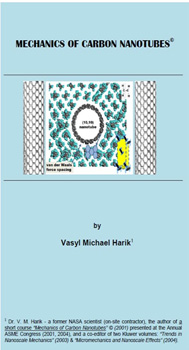Jan 24 2012
Since Galileo Galilei in the 17-th century, mechanics has become the basis of modern physical sciences. A statement that a science only then becomes a science, when it starts using mathematics belongs to Galileo, who advocated a rigor and specificity in the description, if not the analysis, of scientific experiments.
 Mechanics of Carbon Nanotubes.
Mechanics of Carbon Nanotubes.
After the discovery of carbon nanotubes in 1991 and 1993 by Iijima and his lab, the analysis of mechanical behavior of the multi wall and the single wall carbon nanotubes has laid the new foundation for the precise description of various nanoscale experiments and Dr. V. M. Harik the nanoscale analysis of new materials, nanostructures and nanoparticles of only 1 nm in diameter, for example, the so called Buckminster ball or the "bucky" ball, i.e., the spherical C60 carbon particles. It so happens that the "bucky" ball is the smallest material particle that satisfies a rigorous nanoscale (homogenization) criterion for the averaging of material properties [1].
In 2001, a classification of carbon nanotubes have been done according to their sizes: diameters, length, their aspect ratio and other key ratios [1]. The aspect ratio of carbon nanotubes is the key parameter in the design of new atomic force microscope (AFM) probes. It is widely known that carbon nanotubes are the strongest material, yet they may fall apart when their radius is about one carbon ring in size. These structurally unstable nanotubes belong to the class of carbon nanocrystals, in addition to other three classes of carbon nanotubes (i.e., the thin and thick nanotube shells and the long or the high aspect ratio carbon nanotubes [1]).
A first nationally distributed short course "Mechanics of Carbon Nanotubes" has been presented at the Annual ASME Congress in 2001 by Dr. Vasyl Michael Harik, then a Senior Staff Scientist at the ICASE Institute at the NASA Langley Research Center, Hampton, VA. In 2011, exactly ten years after the first presentation of that short course, a new book with the same title has been published by a 2004 NASA spin-off, Nanodesigns Consulting of Newark, DE. The new still emerging field of nanomechanics is, probably, one of the simplest parts in the conceptual foundation of new nanoscale sciences and the nanotechnology. It is an essential part of the new nanotech education.
[1] V. M. Harik, Mechanics of Carbon Nanotubes, 2011. Nanodesigns Press, Nanodesigns Consulting, P.O. Box 9090, Newark, DE 19714-9090.